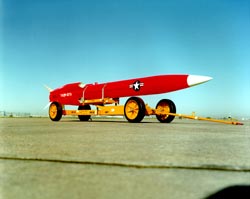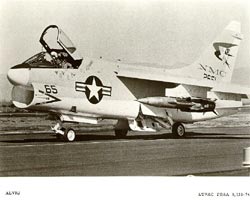|
 The ramjet engine was exploited by many countries including the United States. The first flight test of a ramjet in the United States took place in 1945. Work leading to the ALVRJ began by the Navy in the 1950’s with the idea of reducing the size of ramjet systems. Early versions of ramjets used separate boosters to obtain ramjet speeds. The low volume ramjet used the concept of an “integral rocket” to reduce volume. After rocket burnout the empty rocket chamber became the ramjet engine chamber thus reducing the total volume. The ramjet engine was exploited by many countries including the United States. The first flight test of a ramjet in the United States took place in 1945. Work leading to the ALVRJ began by the Navy in the 1950’s with the idea of reducing the size of ramjet systems. Early versions of ramjets used separate boosters to obtain ramjet speeds. The low volume ramjet used the concept of an “integral rocket” to reduce volume. After rocket burnout the empty rocket chamber became the ramjet engine chamber thus reducing the total volume.
Work on the integral rocket ramjet concept was performed by the Marquardt Corp. for the US Air Force in the early 1960’s. This effort was not entirely successful in that successful transition from boost propulsion to ramjet propulsion was never achieved.
 The initial integral ramjet work performed by the Navy was performed by Chance Vought Aircraft and Texaco Inc. The ALVRJ Program was started in 1968 under contract to the Navy (N0019-68-0605) with the objective of demonstrating the flight performance and mission capabilities of an integral booster air-launched low-volume ramjet tactical missile system. Both air-launched and ship-launched tactical systems were envisioned by the Navy. The initial integral ramjet work performed by the Navy was performed by Chance Vought Aircraft and Texaco Inc. The ALVRJ Program was started in 1968 under contract to the Navy (N0019-68-0605) with the objective of demonstrating the flight performance and mission capabilities of an integral booster air-launched low-volume ramjet tactical missile system. Both air-launched and ship-launched tactical systems were envisioned by the Navy.
Six dynamic test vehicles (DTV) plus ground test hardware were fabricated to provide data for analysis and future engineering development of the integral rocket ramjet engine system. The first flight test was conducted in 1974. The program was completed in 1976 with complete success. The ALVRJ demonstrated successful transition from rocket to ramjet operation with cruise at a speed in excess of Mach 2.5 and flights at sea level and 35,000 feet.
The vehicle placed no significant restrictions on its launch aircraft. In each of five flight tests, the ALVRJ demonstrated stable controlled separation from the launch aircraft, smooth transition to ramjet operation, and stable cruise performance. In addition, lateral turns, pullups and pushovers demonstrated the controllability of the vehicle and satisfactory operation of the ramjet engine at the angles of attack expected for tactical operations.
|